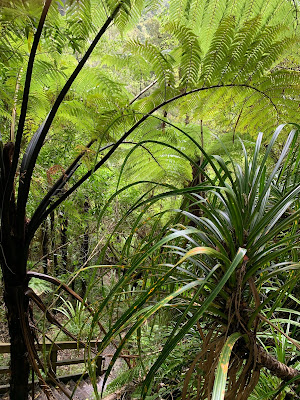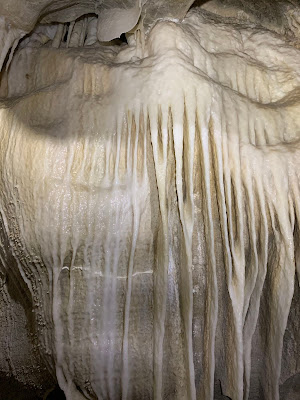We
started our tour with a mini-train ride through the temperate rain forest. I asked about why this mini train was built,
but didn’t get a real answer other than the owner decided to build it in
2002. It brought us to a trailhead
through the forest to the mouth of the cave.
Crossing a suspension bridge to get to the cave
Jungle hiking
Our guide said there are over 160 types of ferns in New Zealand. I’m sure more than six were around me, but here are a few that I took pictures of.
The cave we
visited was a very young cave geologically.
It was discovered in 1960. It has
over 5 miles of tunnels that have been discovered so far. It is on public land, but leased by the tour
company. Its a limestone cavern and one
of over 200 in this region of the country.
Unlike
the yellow coloration at the thermal springs which was due to sulphur
content, the yellow in the caves was from pollen that was picked up in the
water that seeped through to the caves.
There was actually not a lot of coloration in the caves, it was largely
very white calcite.
Our group holding clear calcite stones in front of our helmet lights.
This part
of the cave was named ‘metro station’ because of the smooth, rounded curve of
the ceiling, its running in a straight line, and the fact that it had a strong
breeze passing through it like the coming of a train into the station.
We
decided this part of the cave looked very much like giraffe skin.
These
columns were broken in the middle and then rejoined. The breaks occurred when the stone in the cavern
shifted and the dripping water eventually joined them back together again, much
like knitting bones.
There
were several entrances to the cave system.
This large entrance was the one that the founder first saw when he
entered this cave. Several very bad
storms have taken down enough trees in the area that it is very hard to
approach on foot anymore. We felt like
we were stepping into Jurassic Park with all the ferns and the filtered
sunlight shining through this entrance.
Our guide
said that the surface water takes about 12 hours to drain through into the caves
when there are rains (which is often).
The water in the caves can come up very quickly. The large chamber at the entrance was
actually completely filled a few years ago.
There are still twigs lodged in the ceiling 30+ feet above the floor of
the cave.
There are
some caverns in the system that don’t actually flood because they trap air in
pockets, like a cup placed upside down in a bowl of water. The air pressure keeps the cup from filling
up with water.
The
highlight of this cave and a number of others around New Zealand were the ‘glow
worms’ (seen here as little pricks of light, like constellations). They excrete a substance (worm poop) that
actually glows to attract bugs into the sticky strands of webbing they drop
from the ceiling of the cave. They are
not spiders, but the mechanism is similar.
When we turned on our lights to look closely at the strands, we actually
saw a bug fly by and then get caught.
This worm immediately moved out from its “hammock” (top part of its network
of strands) and started pulling in the insect to eat it. Because the worm was worms are largely
transparent, we could actually see the bug going down as it was eaten. Wild!




























No comments:
Post a Comment